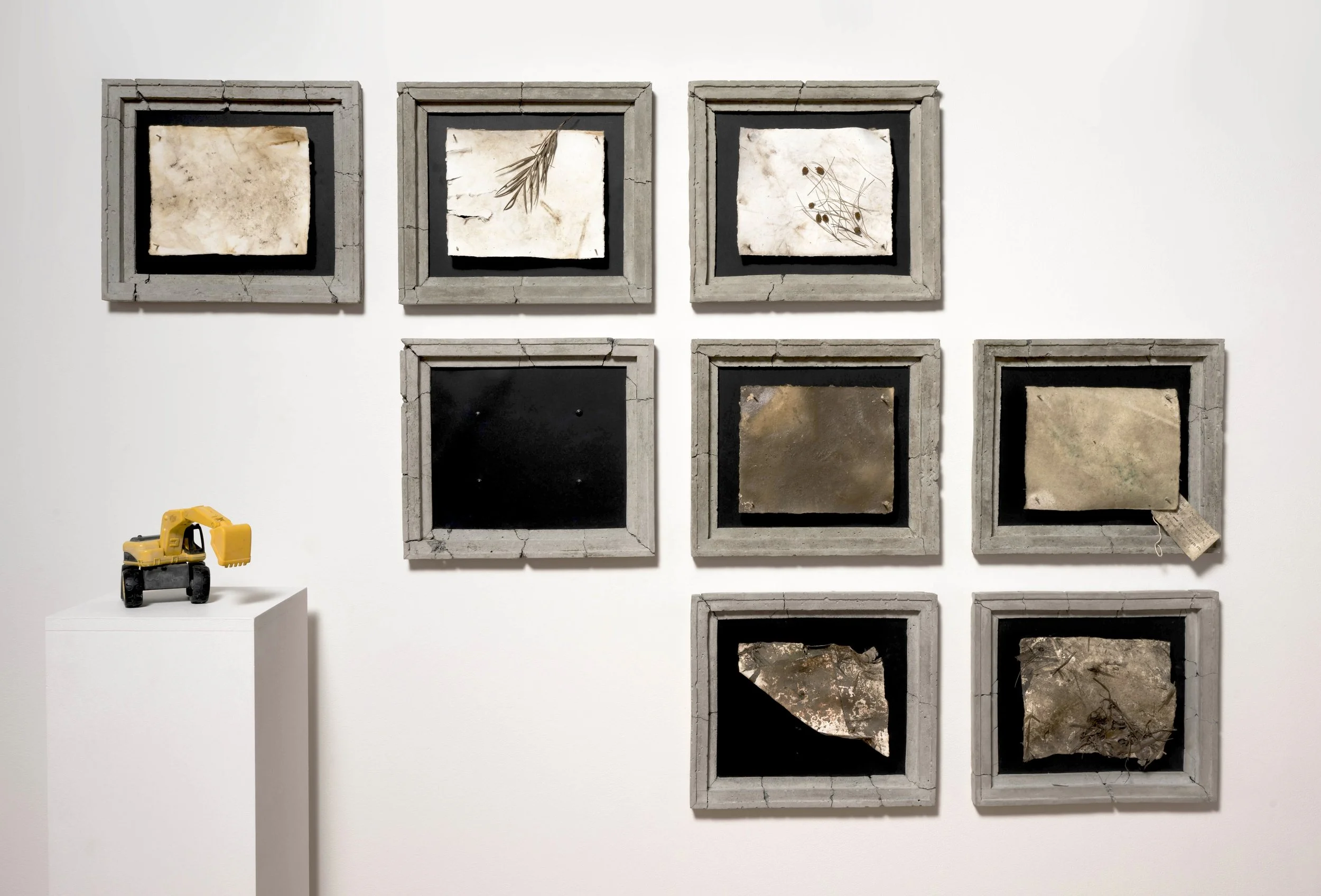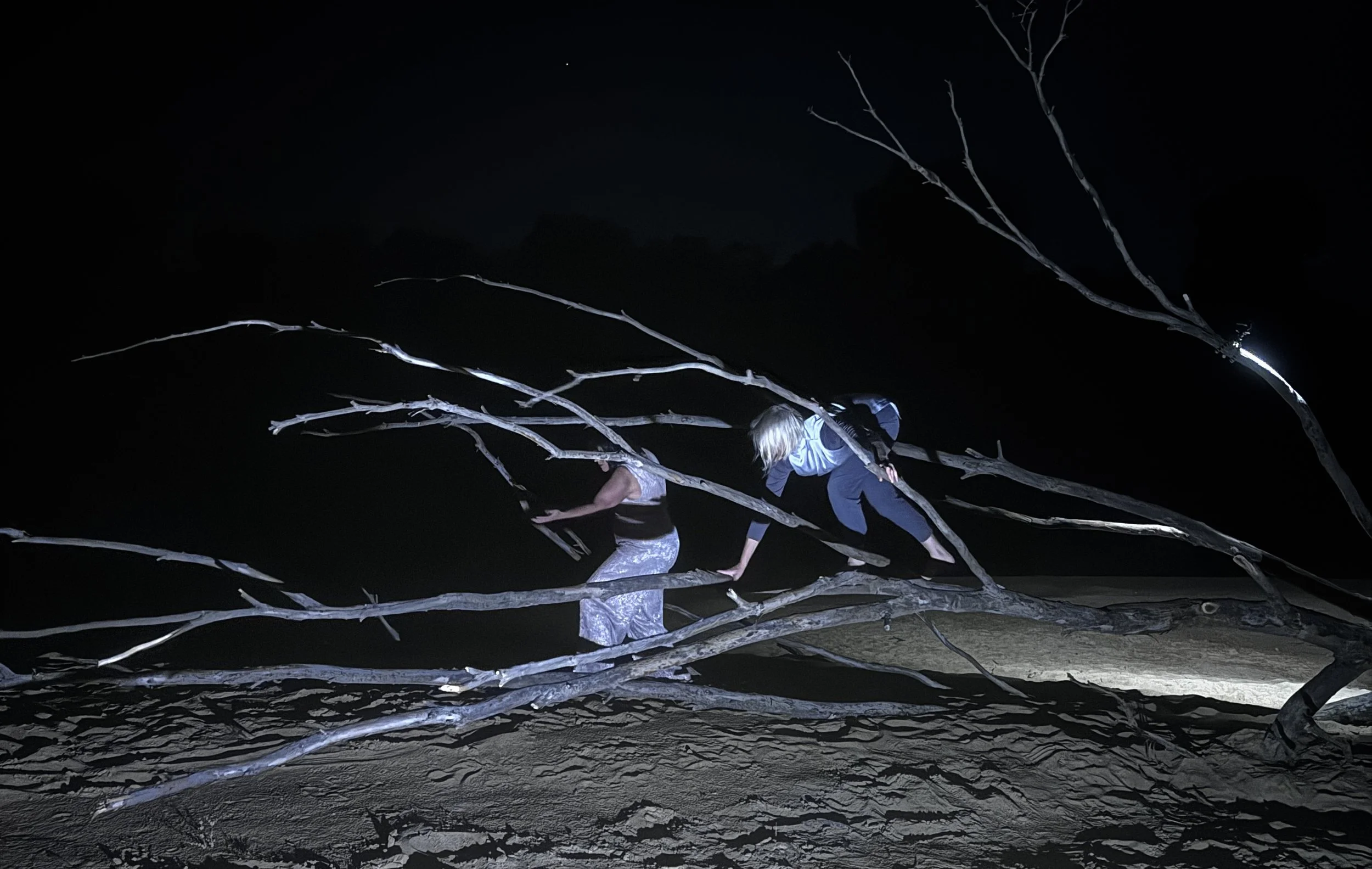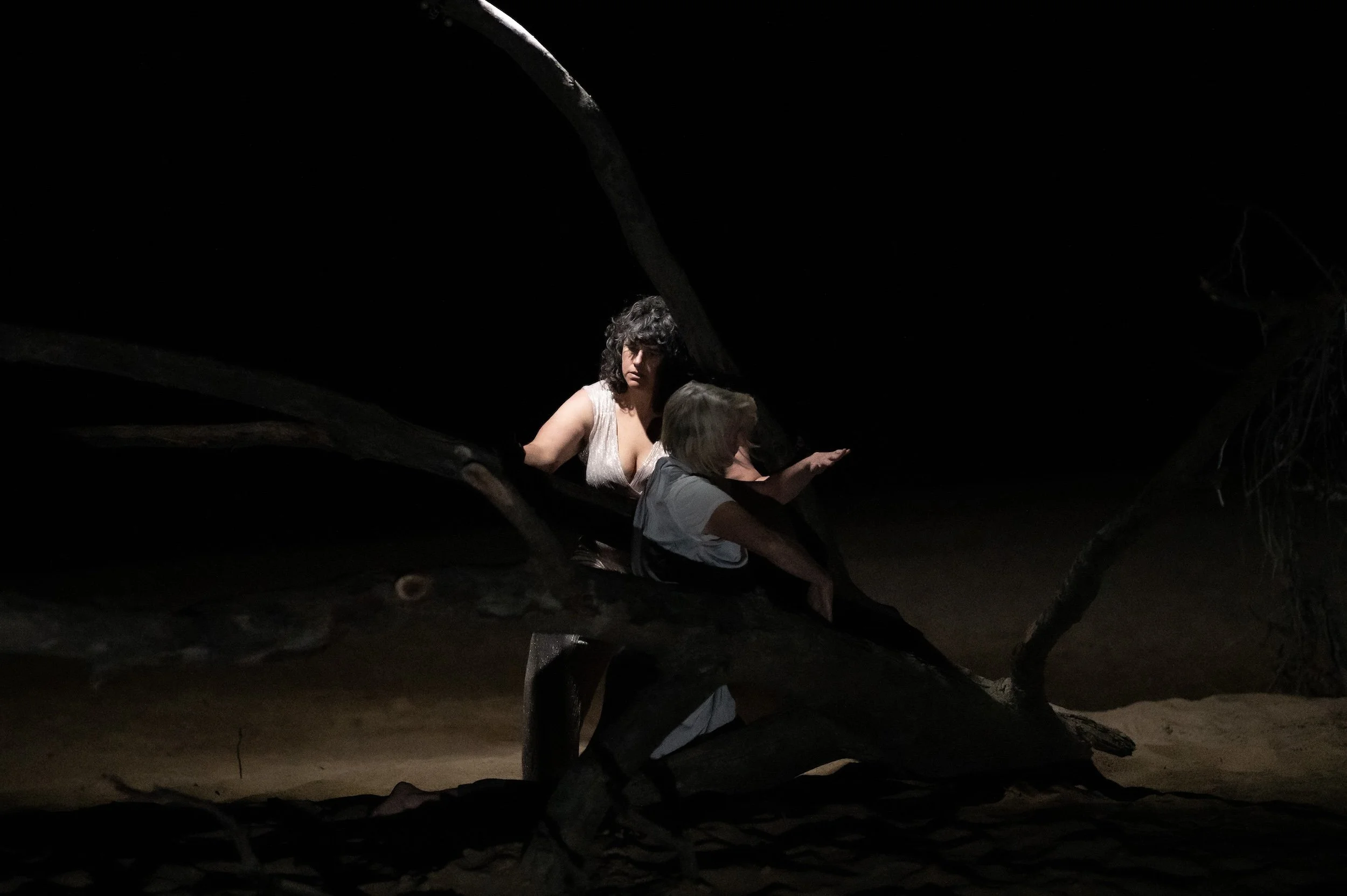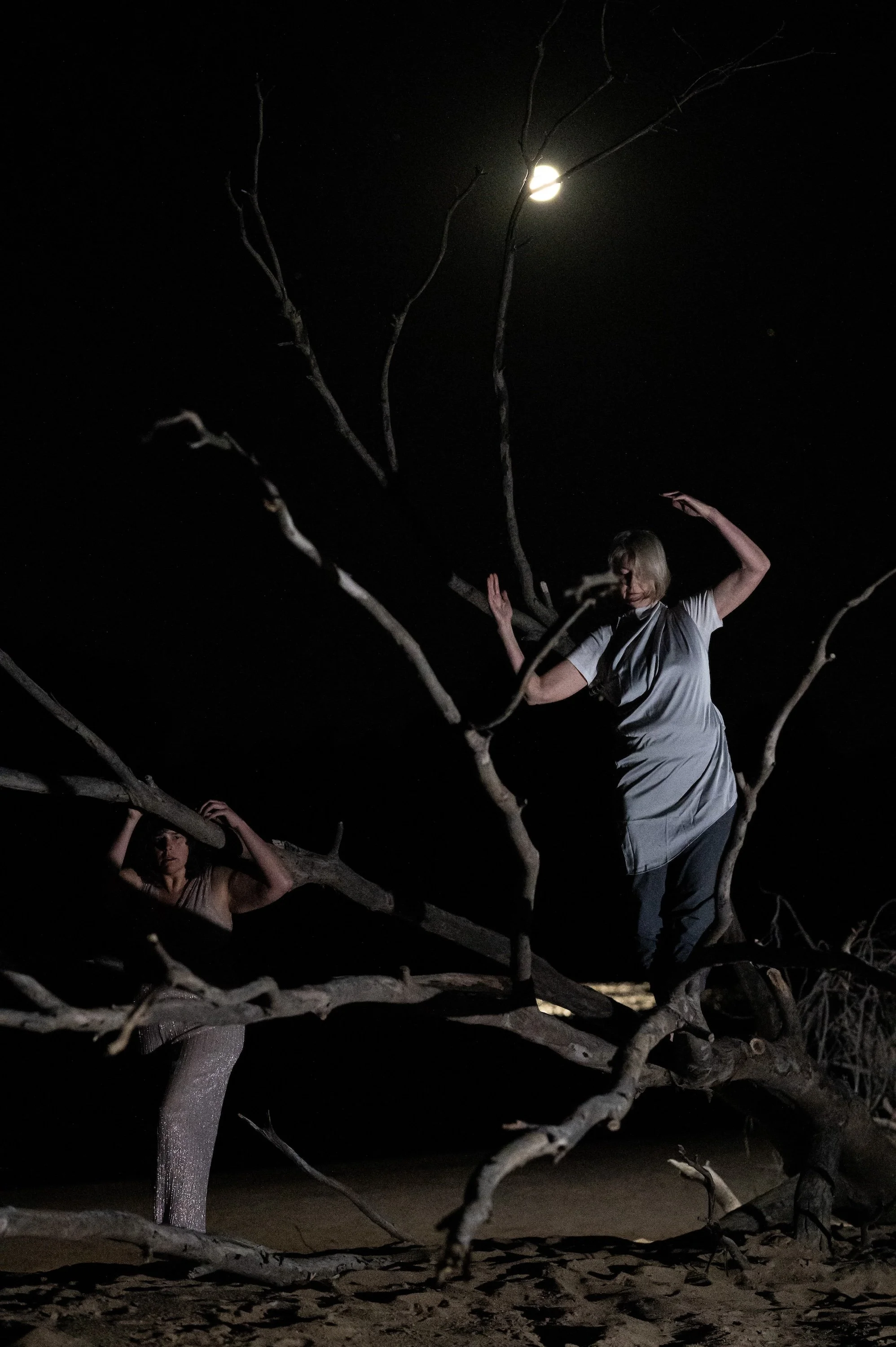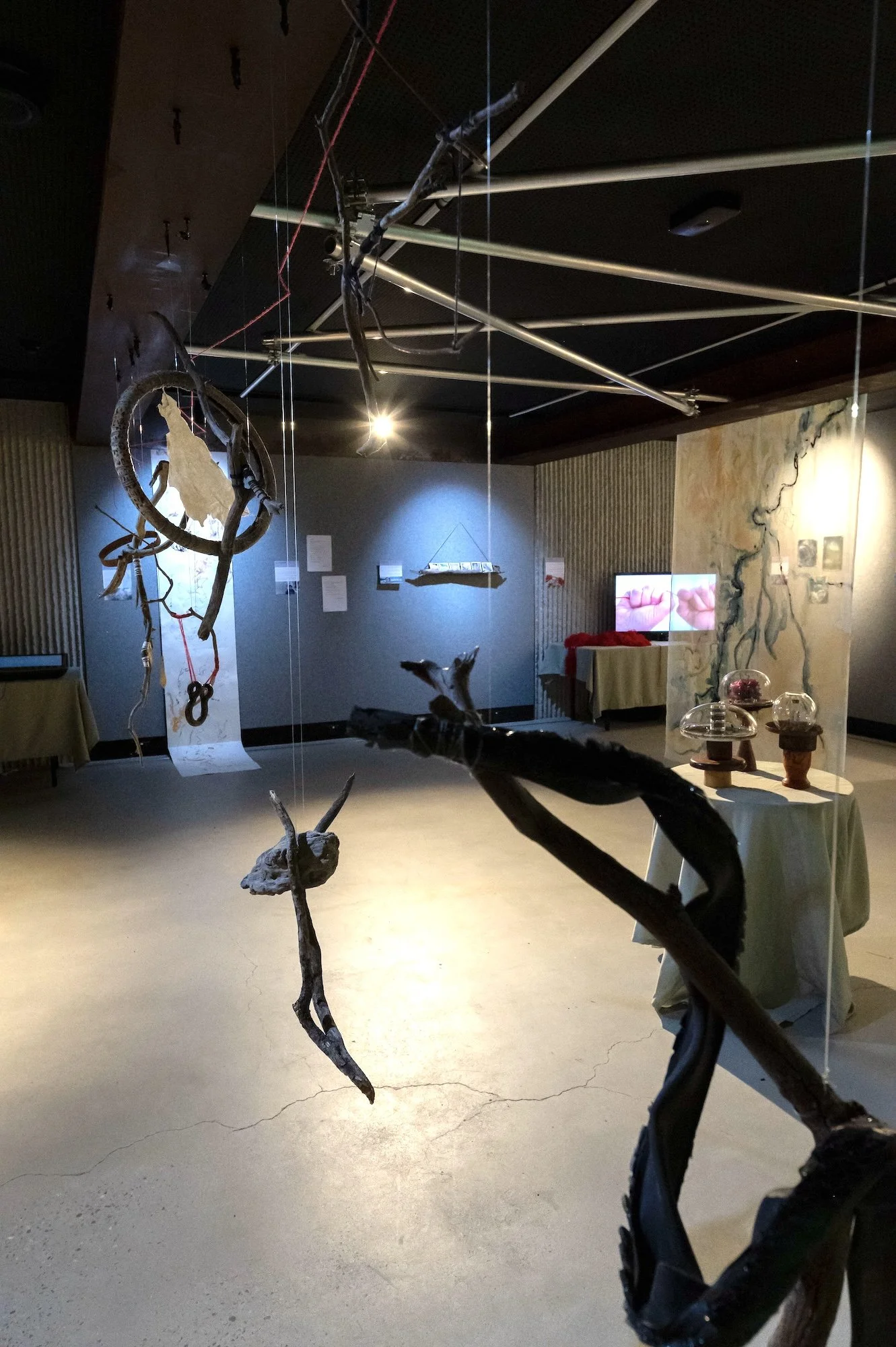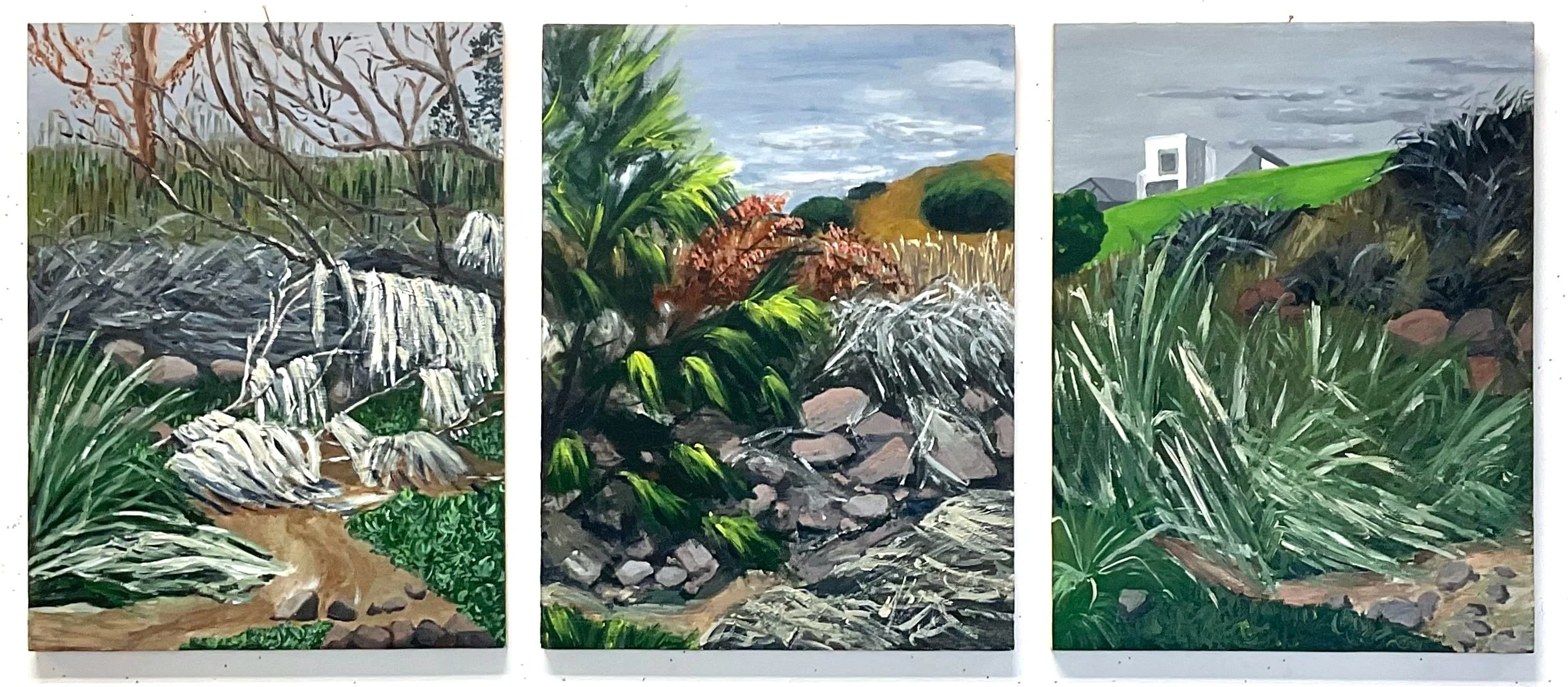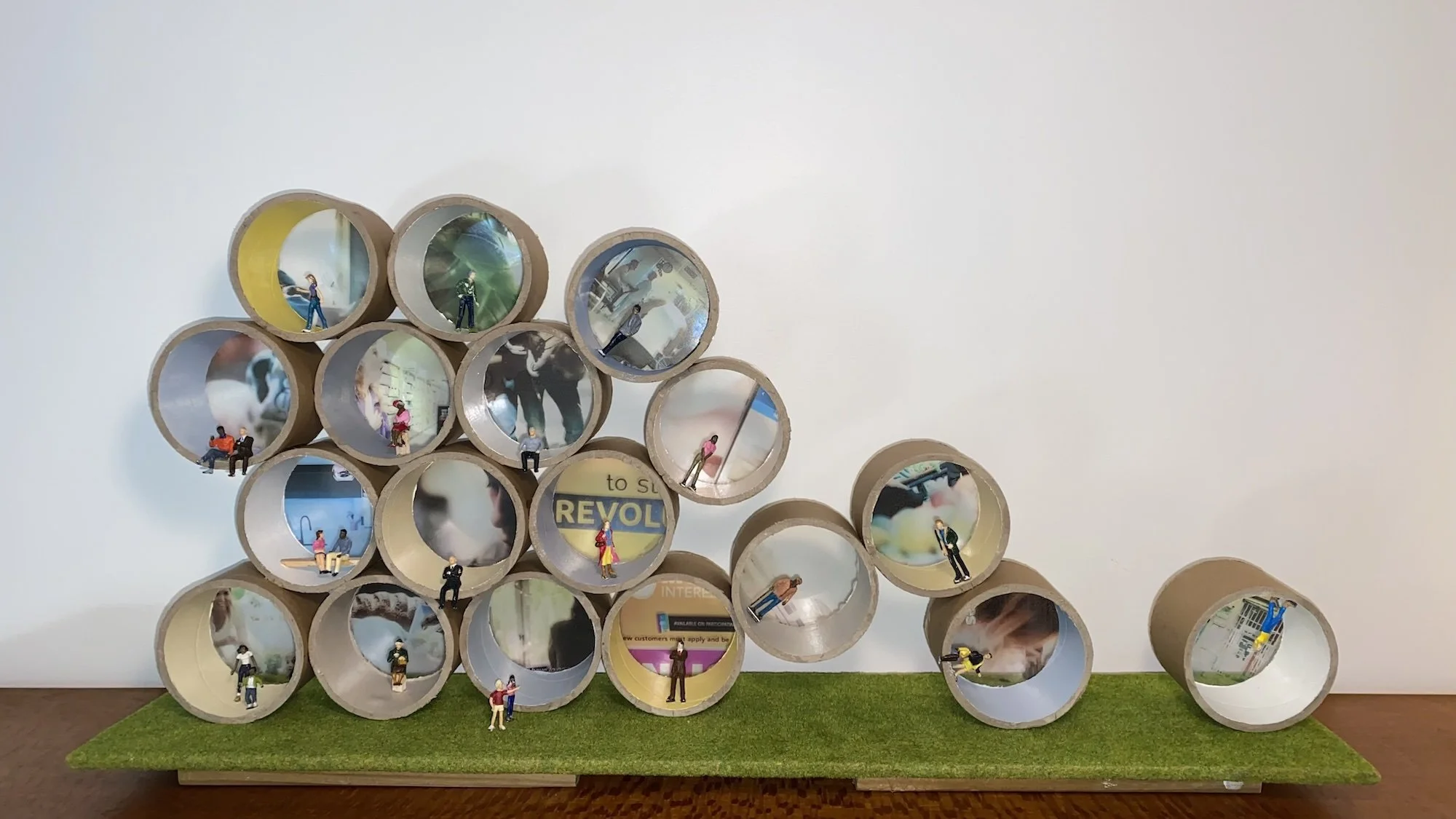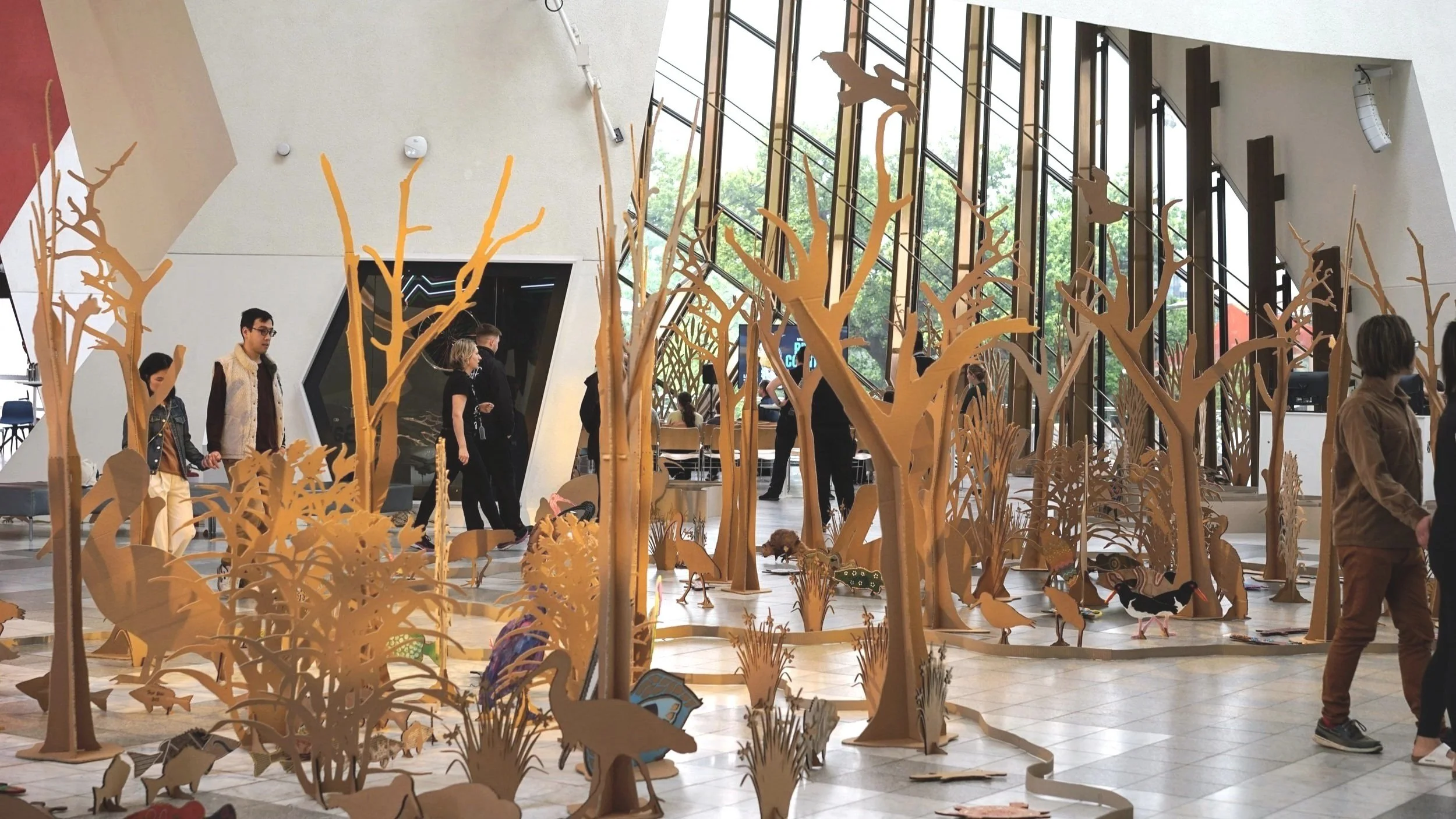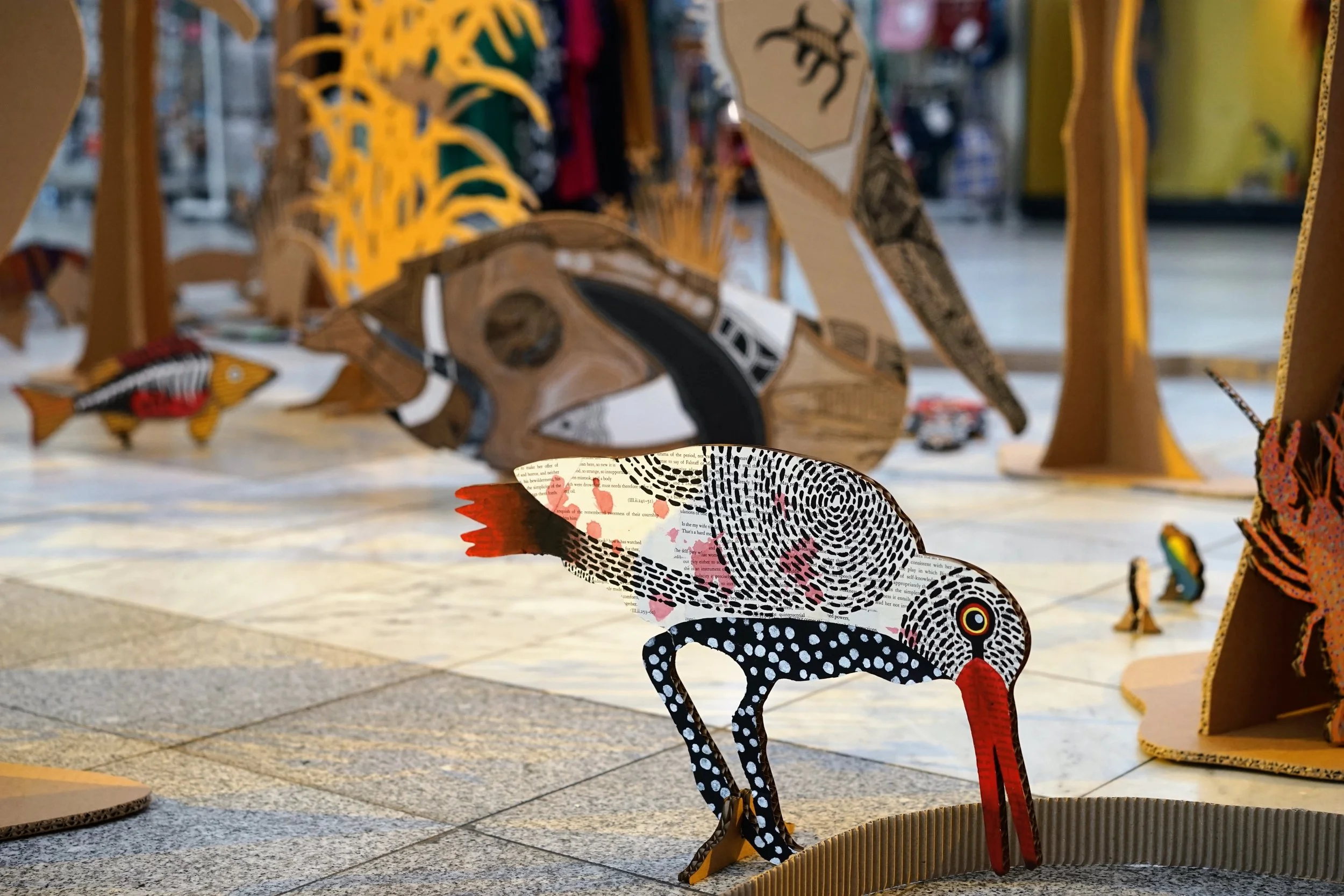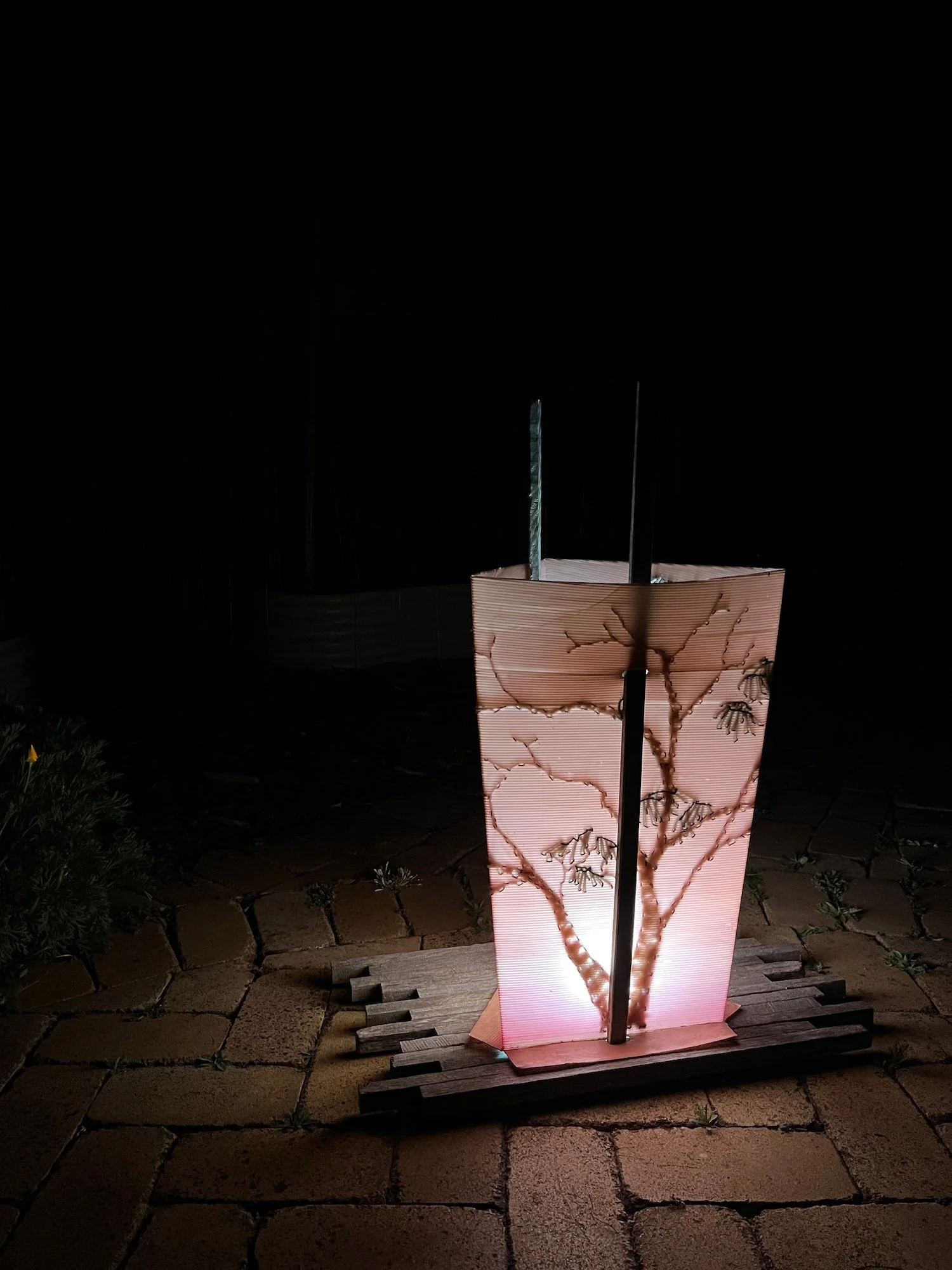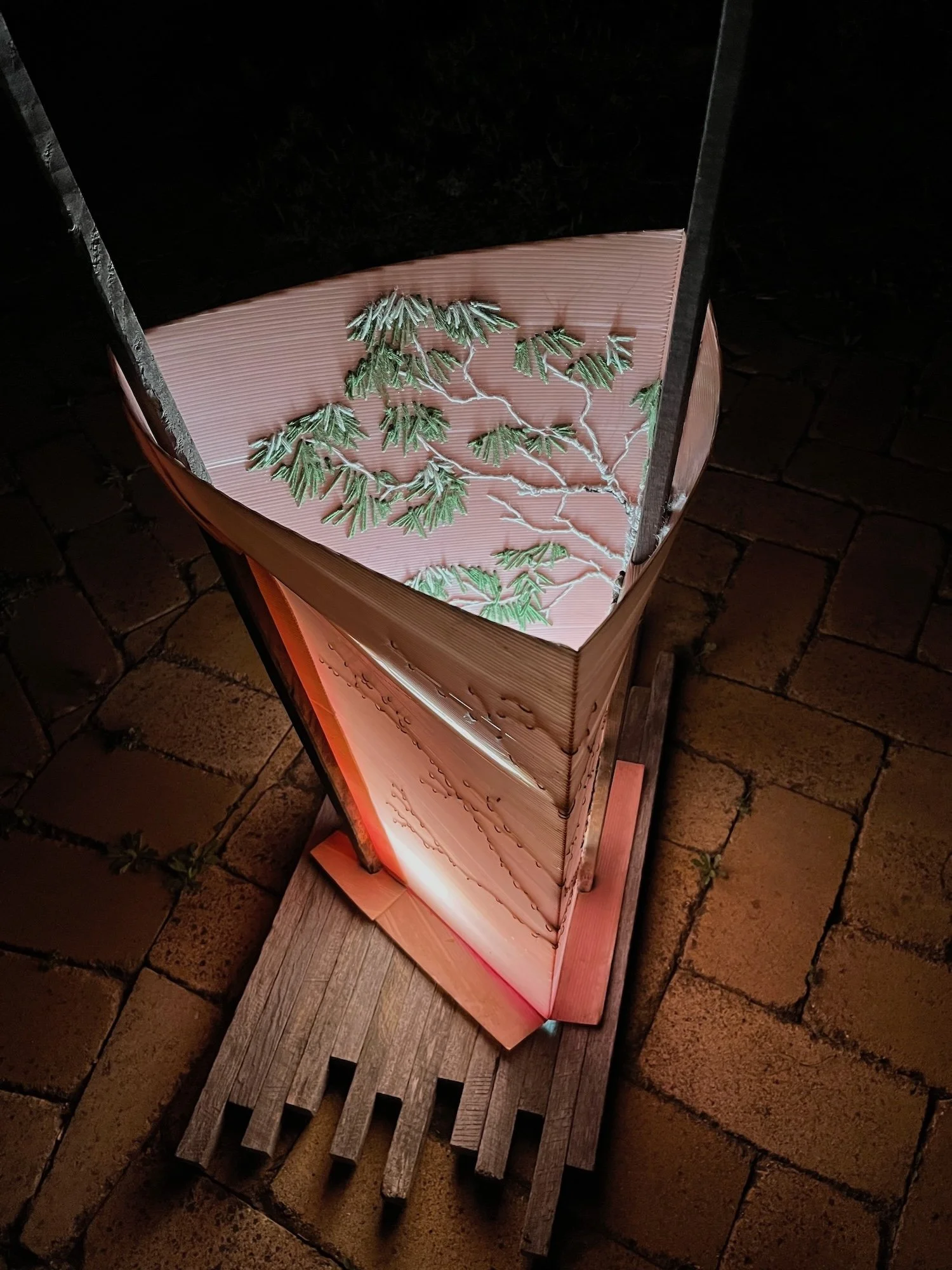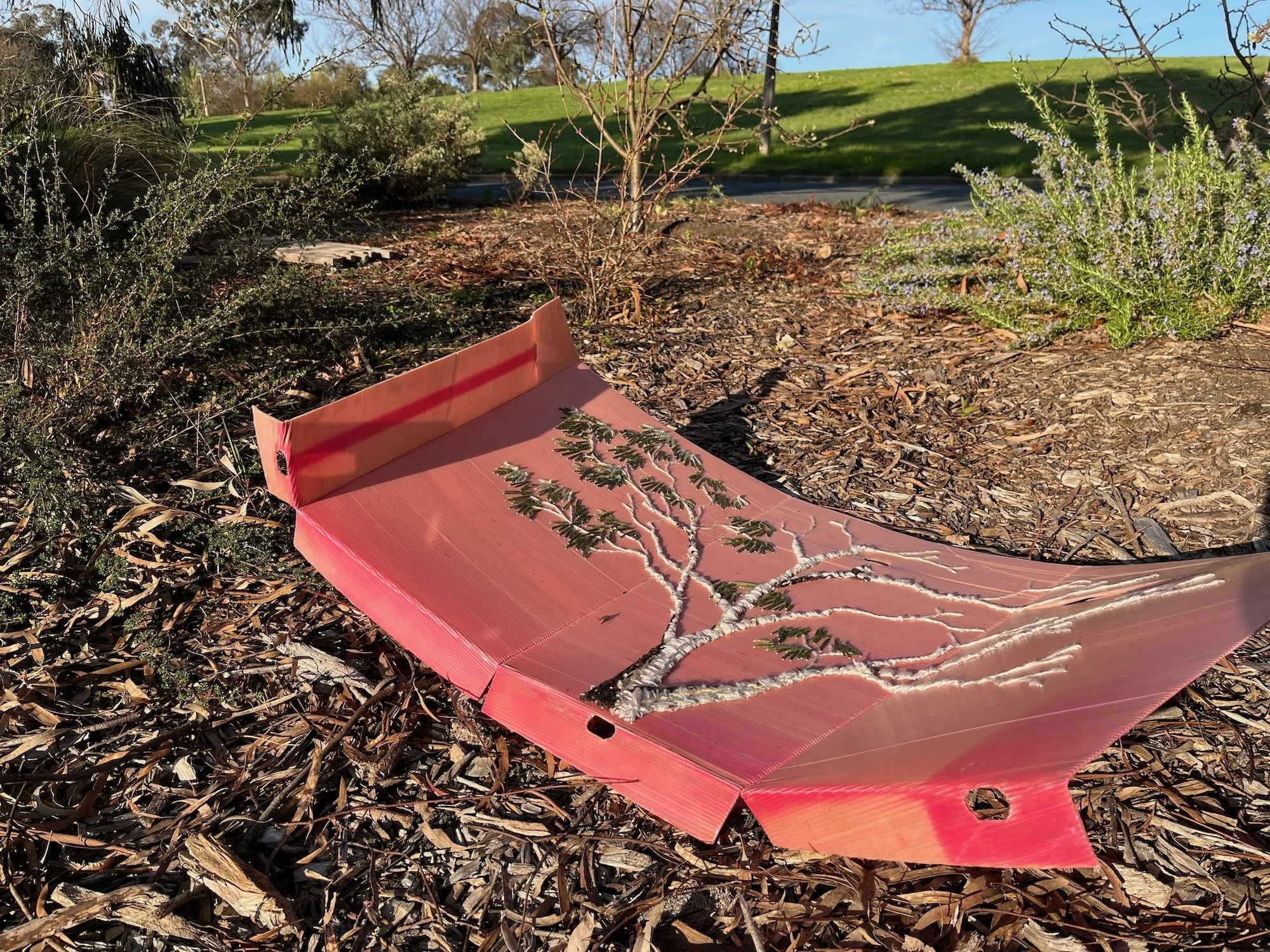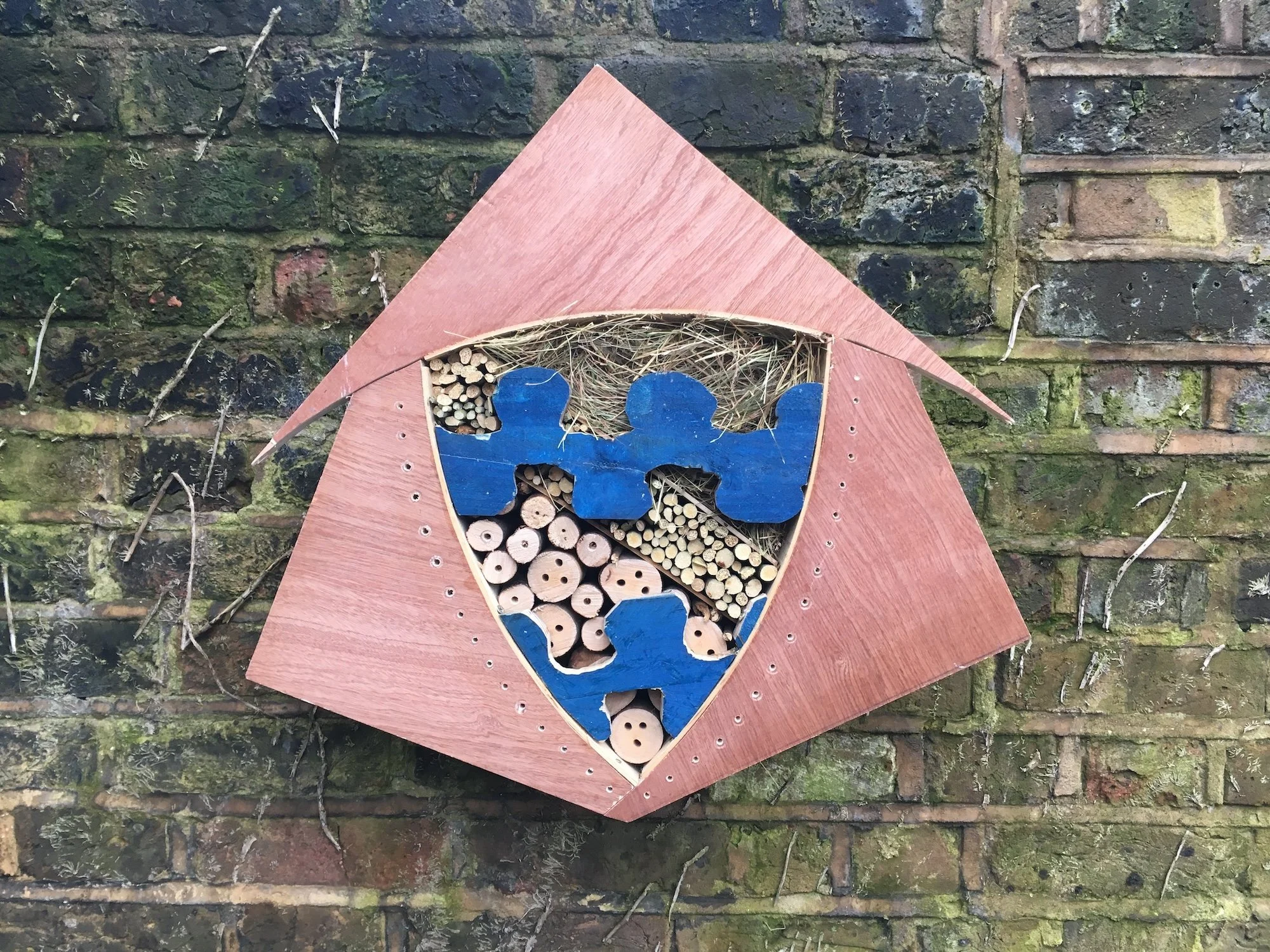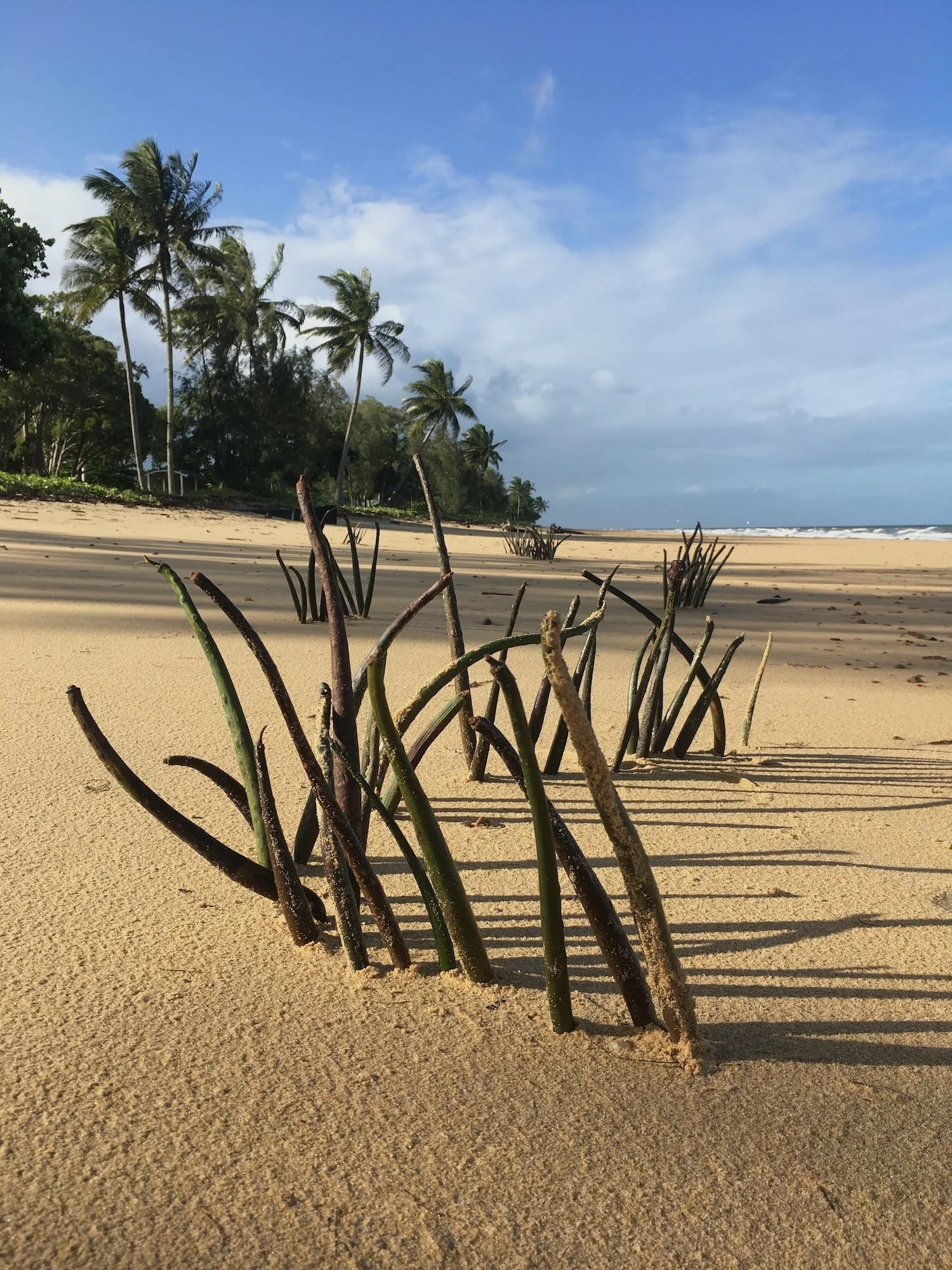Artworks & Installations
Kirsten Wehner, Flow Story, concrete, papers and found plastic object, 2025. Image: Brenton McGeachie
Creek (24 Jan - 16 Feb 2025), M16 Artspace, Canberra
Comprising the major outcome of my M16 Artspace/Concept Six Environmental Artist Residency (2024-25), Creek was a solo exhibition presented at M16 Artspace in Canberra. Including watercolour and pastel drawings, sculptural works employing embroidery and found objects and a substantial installation piece exploring watery agency, Creek traced life along a little-loved suburban waterway.
Creek asked what it might mean to care better for the disordered place of Weston Creek in south-western Canberra. The exhibition responded to Ngunawal teachings of the waterway as ancient and lively Country, to local park care groups regenerating areas of catchment habitat, and to the never-ending re-engineering of the waters’ deeply disrupted flows. As well as documenting some of the human and non-human stories of the waterway, Creek sought to notice the waterway’s telling of its own story; the ways in which it shares its hope for its future in rain, sap, silt and crumbling concrete.
More than a Fish Kill, digital video still, 2024. Videography: Otis Filley, courtesy National Museum of Australia.
More than a Fish Kill (2024)
More than a Fish Kill is a 38-mins documentary following a collective of artists, scientists and First Nations custodians who came together in the wake of devastating mass fish losses along the Barka (Darling River). Together, they turned these ecological disasters into a journey of cultural connection and healing, revealing what happens when arts, science and ancient knowledges interweave to chart new ways of honouring, caring for and living with our rivers. More than a Fish Kill was produced by the National Museum of Australia, the Cad Factory and Otis Filley Studios. My roles included contributing as Executive Producer and as part of the direction, writing and producing teams.
Kirsten Wehner and Maggie Ellis, Deposit, performance, Apex Beach, Mildura, 2024. Image: Rhae Kendrigan
Deposit (2024)
Developed in collaboration with Maggie Ellis, and with choreographic support from Linda Luke and Peter Fraser, Deposit was an improvised performance responding to a dead tree embedded in the Murray River bank at Mildura. The work was performed as part of the Borders Festival at Apex Beach, Mildura on 26 April, 2024.
Contesting the idea of ‘deadwood’, the work explored past, present and future lives of the tree, reflecting on its emergence and growth, experience of the cataclysmic flood that tore it up and transported it to the beach, transformation to a sculptural form as it sinks slowly into the sand and continuing role in the river’s ecological well-being.
Images below: Photos: Roberto Pettinau
Kirsten Wehner, Flood(plain), installation view and detail, Mildura, Vic, found objects and wool, 2024. Image: Robert Pettinau
Flood(plain) (2024)
Comprised of artefacts collected along the Murray River at Echuca/Moama and assembled with wool, Flood(plain) considers the experience of recent flood events. It is a work about turbulence, about raining and rising, rushing and pooling, and also the slow of settling and sedimenting. In a river system rendered fast-flowing/stopping through infrastructure and management interventions, climate changed downpours and droughts and de-vegetated riparian zones, body-objects of many origins are carried along in the currents, suddenly heavy, liltingly light, twisting, battered, tangling into strange others. Turned and turned to learn the world anew. And then, left in muddy companionship, held in silt’s embrace, a memory of flows.
Flood(plain) was exhibited at the Borders Research Lab exhibition, Mildura, 26-28 April, 2024
Kirsten Wehner, On Beauty, installation view, Belconnen Arts Centre, gouache, markers, rice papers and foam boards, 2022. Image: Gemma Fischer Photography
On Beauty (2022)
On Beauty re-considers Weston Creek, presenting a collaborative exploration of this hard-used waterway as a site of inspiration. Local residents joined artist Kirsten Wehner to walk the creek’s concreted drain, exploring the waterway’s story, trying to look anew and direct printing to record experiences of beauty. Kirsten then collaged these responses into a collective work, with impressions of algae patterns, rock colours, leaf shapes and waterbug journeys reimagine this unloved landscape as a space for connection, restoration and care.
On Beauty was exhibited in Upending : Mending, Belconnen Arts Centre, May/June 2022.
Kirsten Wehner, Debris (Weston Creek), acrylic paint on plywood boards, 2022. Image: the artist
Debris (Weston Creek) (2022)
Debris explores the lower reaches of Weston Creek, a place of invasive weeds, flotsam and erosion but where the creek still flows and life still flourishes. Inspired by 19th century myrioramas, the work comprises a set of three panels which may be arranged in any order. Each panel presents a ‘view’ of the creek, but their fluid arrangement suggests the impossibility of any ‘objective’ or comprehensive understanding of the waterway. Debris considers Weston Creek as a disorded waterscape, a place that embodies complex histories of colonisation, the challenge of non-Indigenous relationships to Country and the creation of urban waterways as neglected ‘shadow places’ exploited to support our cities but hidden from view.
Kirsten Wehner, Topple (Situation Normal), found cardboard tubing, printed acetate, painted plastic figures, 2021. Image: the artist
Topple (Situation Normal) (2021)
Topple (Situation Normal) responds to my experience of the 2021 COVID lockdown: spending more time at home, enjoying being apart from a lot of other people, watching screens even more than I usually do, noticing how weird everybody on Netflix looks and gazing out the window. The work expressed my dwelling on how our society is obsessed with the idea of 'normal’. The talk is all about carrying on as if nothing needs to change, hoping that it’ll all just go back to how it was. We react to the world as if it is just another TV show. This is about COVID, of course, but also about all the bigger-than-individual problems that we face, like climate change and poverty.
Kirsten Wehner, Shelter, air dry clay, steel, aluminium foil, acrylic paint, sycamore seeds, wood, 2021. Image: the artist
Shelter (2021)
Inspired by watching my partner scoop up a moth that. had found its way into our house, in order to release it outside, Shelter honours acts of care across species and asks how we can extend our empathy with individual creatures to practices of protection for whole species. The work references an over-sized hand, but also a granite boulder like those that characterise the High Country. Inside, ‘bogong moths’ huddle, seeking cool and dark to aestivate, while they are also sycamore seeds, emblematic of ‘naturalisation’ histories that sought to replace native habitat with introduced species hugely deleterious to the survival of creatures like the bogong.
S.A. Adair and Kirsten Wehner, Wetland (River Country), installation view (detail), National Museum of Australia, 2023. Image (and below): Damien McDonald, courtesy National Museum of Australia
(Wetland) River Country (2023-5)
Developed in collaboration with S. A. Adair, Wetland (River Country) was a substantial pop-up installation first presented at the National Museum of Australia’s River Country community day in October, 2023. Constructed from corrugated cardboard forms, the installation evoked the species and forms, the vibrancy and fragility of a Murray-Darling river system wetland. Contributed works by over ninety community artists (see images below) revealed how wetland ecologies are inseparable from river people’s stories, memories, fears and dreams.
During 2024-5, Wetland (River Country) toured to three venues in regional NSW as part of an extended River Country experience. In each location, the installation provided an inspiring platform for facilitated workshops supporting school students to develop artworks sharing their river stories. These student works were progressively added to the installation, creating a collective statement about the cultural values of Murray-Darling waterways.
Kirsten Wehner, Promise, installation view, found corflute tree guard, found timber and wool, 2022. Images: the artist
Promise (2023)
Along many of Canberra’s waterways, pink corflute tree guards protect seedlings planted by government contractors or volunteer groups. Often, these guards persist in the landscape long after their little trees have outgrown them, sometimes remaining wrapped around bulging trunks or blowing away to lodge in waterways. Promise responds to this strange peppering of conservation areas, reflecting on our complex relationships with the non-human world in a time of ecological loss.
Through the labour of embroidery, the work seeks to honour the care and commitment embodied in the act of tree planting and celebrate the ways in which these efforts constitute an investment in a flourishing future. At the same time, Promise draws attention to the ways in which these acts of care are compromised, even over-ridden, by our reliance on mass-produced, disposable products that pollute the environment and diminish its beauty. The promise of an act of love is both protected by the guard, but also hidden by it.
Promise was exhibited in Notions of Place, M16 Artspace, Canberra, 1 - 24 November, 2024.
Kirsten Wehner, Bark, installation view, Sheepstation Creek, near Bombala, NSW, found ribbon gum bark, 2021. Image: Maurice Patten
Bark (2021)
Bark comprises an ephemeral installation in the forests of Sheepstation Creek, near where the ancient First Nations pathway, the Bundian Way, crosses from the Monaro to the coastal plains. In this place, great bark tendrils trail down to the forest floor from tall ribbon gums. These fluid forms create a series of sylvan narratives, each inviting me to wonder about the other lives going on around me. Bark takes the form of an incompetent potoroo shelter, a poorly constructed gesture that might provide refuge for the endangered marsupials that may or may not live in this forest, particularly as recent bushfires have decimated the ground cover that protects them from feral cat predation. The work is intended to fall apart and disappear, as insubstantial as my understanding of this Country.
Bark was exhibited in Shaping Stories, ANU School of Art and Design digital exhibition, Oct, 2021.
Kirsten Wehner, Poplar Place, installation view, Crane River Park, London, UK, 2018. Image: the artist
Poplar Place (2018)
Commissioned by the Friends of the River Crane Environment, Poplar Place is a participatory permanent artwork installed in 2018 in situ to commemorate an iconic tree that lived along the Crane and increase habitat in the park. The several centuries old black poplar died and park managers trimmed the tree tops to make it safe. I developed a design for an interactive installation that honoured the poplar through reflecting its mature shape, while using its lopped branches to create a new stag beetle loggery. Stag beetles, as larvae, eat buried, decaying timber and their habitat has been greatly reduced due to park ‘tidy-up’ aesthetics. The installation was built collaboratively with parkcare volunteers. Its logs fall to the ground or rise skywards, depending on your point-of-view, referencing natural cycles of decline and growth, while also decaying over time to slowly feed stag beetles as the poplar returns to the soil.
Kirsten Wehner, Guild House, installation view, Goldsmiths College allotment, London, UK, recovered scrap timber, grass, acrylic paint, 2018. Image: the artist.
Guild House (2018)
Installed in the Goldsmiths College allotment in London, Guild House is a site-specific work re-interpreting the coat-of-arms of the Guild of Haberdashers, the original owners and builders of Goldsmiths’ campus. The work takes the form of a functioning insect house in the shape and style of the coat of the arms, raising questions about the site’s more-than-human histories and futures.
Kirsten Wehner, Stag Beetle City, air dry clay, modelling surface materials, wood, painted plastic figurines, 2018. Image the artist.
Stag Beetle City (2018)
Responding to London’s status as a conservation hotspot for endangered stag beetles, Stag Beetle City re-imagines part of Peckham Gardens as a place shared by people and stag beetles. Realised as a 3D model, the city incorporates four types of beetle architecture, reflecting spaces created by beetles during their lives. These spaces are envisaged at human-scale so that visitors can sit, snuggle, wander and envisage life as a beetle. Speakers project sounds made by stag beetles as subterranean larvae, while engraved texts on wooden pillars share stories of human-beetle encounters. The final city design was evolved through a workshop inviting the public to explore their lives as stag beetles.
Stag Beetle City was exhibited in Shaping Stories, Central Saint Martins, London, 18-24 June, 2018.
Kirsten Wehner, Tidelines (Mission Beach, Qld), installation, mangrove propagules, 2020. Image: the artist
Tidelines (2020)
Created as an ephemeral installation on Mission Beach on the Cassowary Coast, Tidelines ‘planted’ mangrove propagules along the high tide marks to reclaim this tourist destination as a more-than-human environment. The work aimed to draw attention to the ways in which commercial development is impacting the region’s mangrove forests.
